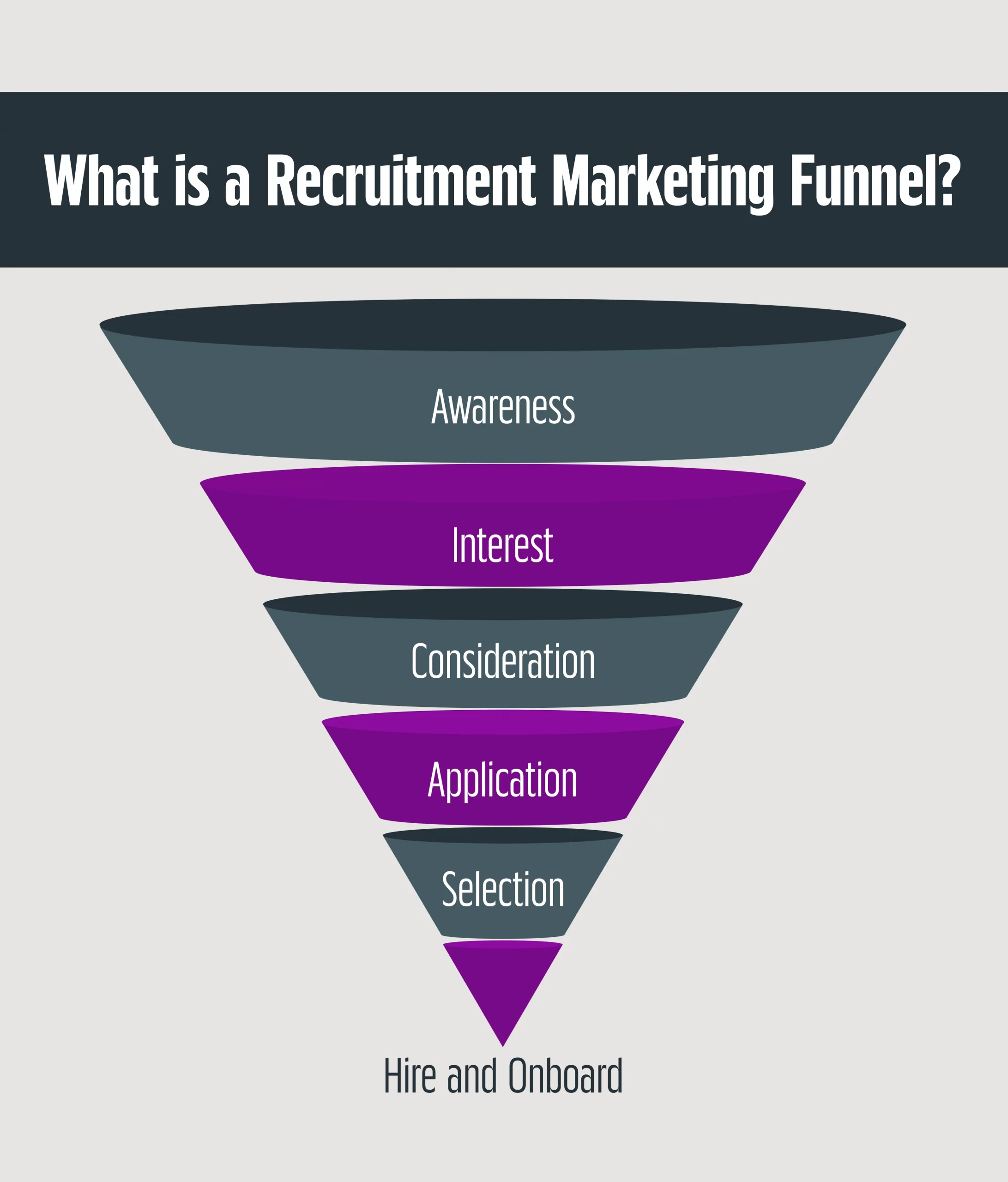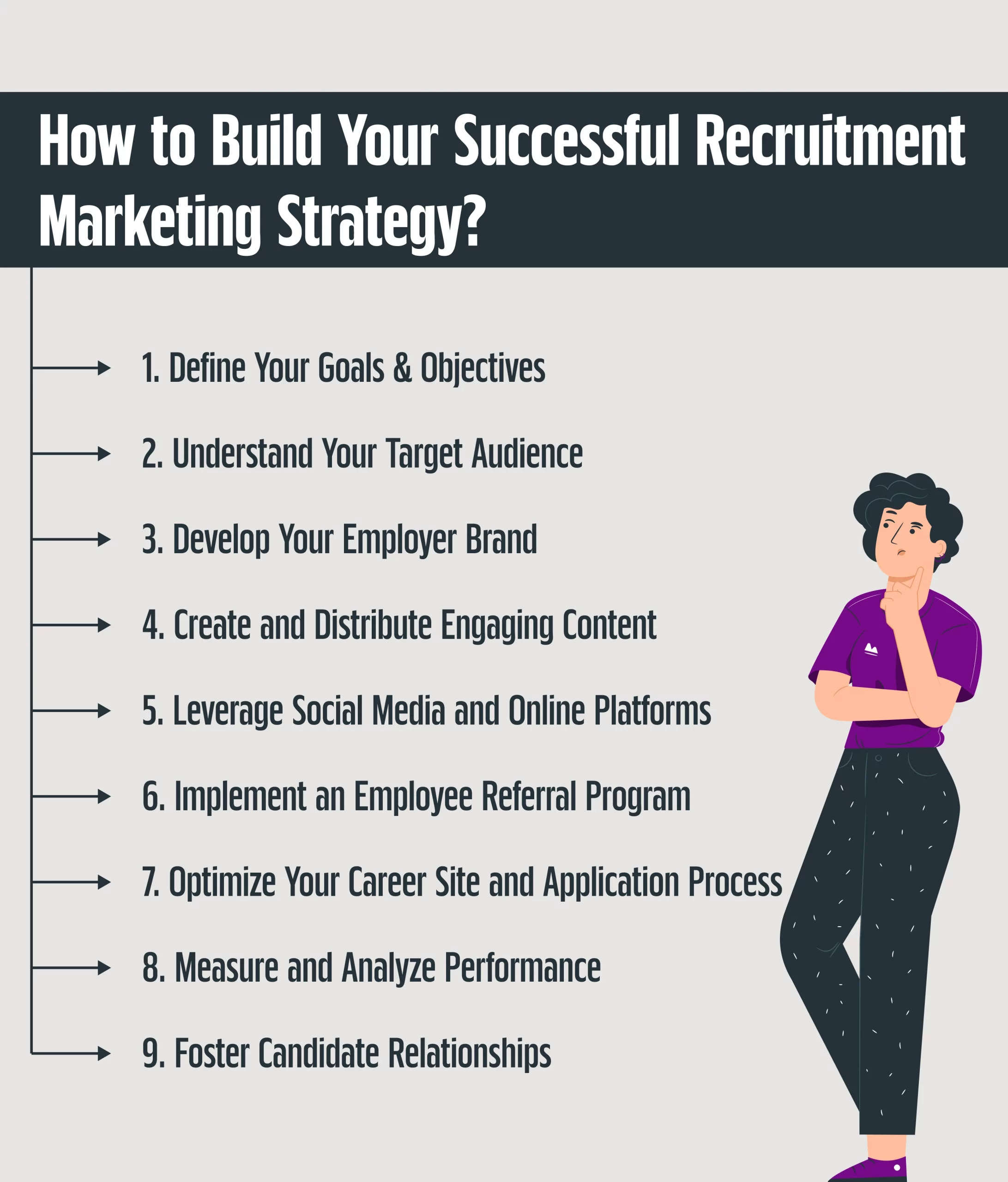Table of content
With the advent of new technologies and the shifting workforce expectations, companies must adapt their recruitment marketing strategies to stay competitive.
This article delves into the best recruitment marketing strategies for 2024, providing insights and practical tips to attract top talent.
What is Recruitment Marketing?
Recruitment marketing refers to an organization’s recruitment strategies and tactics for attracting, engaging, and nurturing potential candidates before they apply for a job.
It encompasses various activities, including employer branding, content marketing, and social media engagement. Unlike traditional recruitment, which focuses on filling positions, recruitment marketing aims to build a strong employer brand and create a pipeline of qualified candidates.
Differences Between Recruitment Marketing and Traditional Recruitment
- Proactive vs. Reactive: Recruitment marketing focuses on attracting potential candidates continuously, whereas traditional recruitment is often reactive, responding to immediate hiring needs.
- Branding Focus: Recruitment marketing emphasizes building a strong employer brand to attract talent, while traditional recruitment centres on filling specific roles.
- Candidate Engagement: Recruitment marketing involves engaging with candidates through various channels over time, while conventional recruitment typically involves direct contact during the hiring process.
What is a Recruitment Marketing Funnel?
In 2024, a well-structured recruitment marketing funnel is crucial for attracting and engaging top talent.
The recruitment marketing funnel helps streamline the process of converting potential candidates into applicants and, ultimately into hires. Here’s a breakdown of how the funnel works:
Awareness Stage
At the top of the funnel, the focus is increasing awareness about your company and its job opportunities. This involves broad strategies like brand building, targeted advertising, and content marketing.
Leveraging social media platforms, engaging in industry events, and optimizing your company’s career page can significantly enhance your visibility. The goal is to make your company a recognizable name among job seekers.
Interest Stage
Once potential candidates know your company, the next step is to spark their interest. This stage involves creating compelling content and experiences that resonate with your target audience.
Use employer branding materials such as employee testimonials, company culture videos, and detailed job descriptions. Engaging content like blog posts, newsletters, and webinars can also help nurture interest and keep your company top-of-mind.
Consideration Stage
In the consideration stage, candidates evaluate whether your company aligns with their career goals and values. It’s crucial to provide detailed information about the roles, growth opportunities and benefits your company offers.
Personalized communication, such as tailored email campaigns and interactive webinars, can effectively address candidates’ questions and concerns. Providing a seamless application process and easy access to information can significantly influence their decision-making.
Application Stage
At this point, interested candidates are ready to apply. Ensure that your application process is straightforward and user-friendly.
Use clear and concise job application forms, and provide a responsive system for addressing any queries or technical issues. A streamlined application process reduces friction and encourages more candidates to take the next step.
Selection Stage
Once applications are received, focus on evaluating candidates effectively. Implement a structured assessment process that includes interviews, skills tests, and reference checks.
Providing timely feedback and maintaining clear communication throughout the selection process helps keep candidates engaged and interested in your company.
Hire and Onboard
After selecting the right candidates, the final step is to make the offer and ensure a smooth onboarding experience. A positive onboarding process sets the tone for the new hire’s experience and contributes to long-term success and retention.
Ensure that new employees are welcomed warmly, introduced to their teams, and provided with the resources they need to thrive.
How to Build Your Successful Recruitment Marketing Strategy?
Building a successful recruitment marketing strategy involves a strategic approach to attract, engage, and convert top talent. Here’s a step-by-step guide to creating a robust recruitment marketing strategy:
Define Your Goals and Objectives
Start by setting clear recruitment goals and objectives. Whether you aim to fill specific roles, enhance your employer brand, or expand your talent pool, having well-defined goals will guide your strategy and measure its success.
Understand Your Target Audience
Identify and understand your ideal candidates. Create detailed candidate personas, including demographics, career aspirations, and preferred communication channels.
This insight will help tailor your messaging and content to resonate with your target audience.
Develop Your Employer Brand
Your employer brand is crucial for attracting top talent. Showcase your company’s unique culture, values, and benefits. Use authentic employee testimonials, engaging videos, and compelling content to build a strong, positive brand image.
Create and Distribute Engaging Content
Content marketing plays a crucial role in recruitment. Develop a variety of content such as blog posts, social media updates, and videos highlighting your company’s strengths and career opportunities.
Share this content across relevant channels to reach and engage potential candidates.
Leverage Social Media and Online Platforms
Utilize social media and job boards to increase your reach. Platforms like LinkedIn, Facebook, and Twitter effectively promote job openings and engage with candidates. Use targeted ads and join relevant groups to connect with passive candidates.
Implement an Employee Referral Program
Encourage your current employees to refer candidates by implementing an employee referral program. Offer incentives and create a streamlined referral process to boost participation and leverage your team’s networks.
Optimize Your Career Site and Application Process
Ensure that your career site is user-friendly and visually appealing. Provide clear information about job openings, company culture, and application procedures.
A smooth and straightforward application process enhances the candidate experience and increases conversion rates.
Measure and Analyze Performance
Regularly track and analyze the performance of your recruitment marketing efforts. Use metrics such as application rates, source of hire, and engagement levels to assess the effectiveness of your strategy. Adjust your tactics based on data-driven insights to improve continuously.
Foster Candidate Relationships
Build and maintain relationships with potential candidates through regular communication and engagement. Email campaigns, newsletters, and personalized follow-ups keep candidates interested and informed about future opportunities.
Conclusion
Building a successful recruitment marketing strategy in 2024 requires adopting digital tools, human connection, and an understanding of the evolving talent acquisition landscape.
By creating compelling employer branding, utilizing data-driven insights, and leveraging the latest recruitment technologies, organizations can effectively attract and retain top talent in the competitive job market in 2024.
If you’re having trouble finding the right candidates for your team, Supersourcing can provide the solution you need. Our team is dedicated to helping businesses like yours connect with top-tier talent. Share your requirements with us, and let us assist you in hiring the best software developers for your company.


